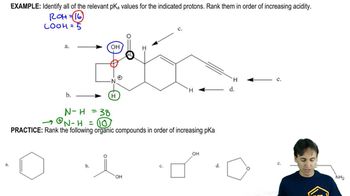Here are the essential concepts you must grasp in order to answer the question correctly.
Hybridization and Acidity
Hybridization affects the acidity of a molecule by influencing the stability of the conjugate base. In general, the more s-character in the hybrid orbital of the atom bearing the acidic hydrogen, the more acidic the compound. This is because s-orbitals are closer to the nucleus, stabilizing the negative charge on the conjugate base. In the given compounds, the hybridization of the oxygen atom plays a crucial role in determining their acidity.
Recommended video:
Using bond sites to predict hybridization
pKa and Acidity
The pKa value is a measure of the acidity of a compound, with lower pKa values indicating stronger acids. It represents the equilibrium constant for the dissociation of an acid into its conjugate base and a proton. In the context of the question, comparing the pKa values of the two compounds helps determine which is the stronger acid, as the compound with the lower pKa will more readily lose a proton.
Recommended video:
Resonance Stabilization
Resonance stabilization occurs when a molecule can distribute its electron density over multiple atoms, stabilizing the structure. In the context of acidity, a conjugate base that is resonance-stabilized is more stable, making the parent acid stronger. For the compounds in question, analyzing the potential resonance structures of the conjugate bases can help explain the differences in their pKa values and thus their relative acidities.
Recommended video:
The radical stability trend.

 Verified step by step guidance
Verified step by step guidance Verified video answer for a similar problem:
Verified video answer for a similar problem:



 9:36m
9:36m